Plus Two Botany Notes Chapter 2 Sexual Reproduction in Flowering Plants is part of Plus Two Botany Notes. Here we have given Plus Two Botany Notes Chapter 2 Sexual Reproduction in Flowering Plants.
| Board | SCERT, Kerala |
| Text Book | NCERT Based |
| Class | Plus Two |
| Subject | Botany Notes |
| Chapter | Chapter 2 |
| Chapter Name | Sexual Reproduction in Flowering Plants |
| Category | Plus Two Kerala |
Kerala Plus Two Botany Notes Chapter 2 Sexual Reproduction in Flowering Plants
Flower – A Fascinating Organ Of Angiosperms
Flower shows aesthetic, ornamental, social, religious and cultural importance. They are used as symbols for conveying human feelings such as love, affection, happiness, grief etc.
Pre-Fertilisation: Structures And Events
The Hormonal and Structural changes leads to the differentiation and development of the floral primordium.
| In the flower the male reproductive structure is the androecium, it consists of a whorl of stamens. The female reproductive structure is gynoecium, it consists of pistils. |
1. Stamen, Microsporangium and Pollen Grain:
A typical stamen consist of the long and slender stalk called the filament, and the bilobed structure called the anther. The number and length of stamens are variable in flowers of different species.

A typical angiosperm anther is bilobed i.e. dithecous.
It is a four-sided (tetragonal) structure consisting of four microsporangia located at the corners, two in each lobe. The microsporangia develop further and become pollen sacs.
Structure of microsporangium:
In young condition anther consist of cells called the sporogenous tissue. It is surrounded by four wall layers.
- Epidermis
- Endothecium
- Middle layers
- Tapetum.
The outer three wall layers shows protective function and help in breaking of anther to release the pollen. The innermost wall layer is the tapetum possessing more than one nucleus. It nourishes the developing pollen grains.
Microsporoqenesis:
During the development of anther, cells of the sporogenous tissue undergo meiotic divisions to form microspore tetrads. This is called microsporogenesis.
At maturity the microspores dissociate from each other and develop into pollen grains.
Pollen grain:
Pollen grain has hard outer layer called the exine, it is made up of sporopollenin (resistant organic material- not degraded by enzyme).
Exine surface shows Germ pores through which pollen tube come out. Exine shows different patterns and designs.
| Pollen grains are well preserved as fossils because of the presence of sporopollenin. |
The inner wall of the pollen grain is called the intine. It is thin and continuous layer made up of cellulose and pectin. The cytoplasm of pollen grain is surrounded by a plasma membrane.
When the pollen grain mature, it contains two cells, the bigger vegetative cell and the smaller generative cell.
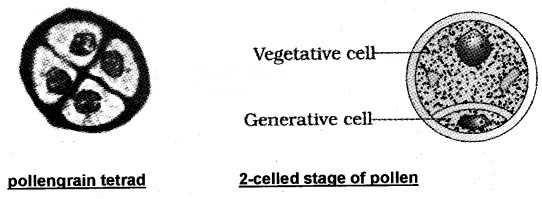
| About 60 per cent of angiosperms, pollen grains are shed at 2-celled stage. In the remaining species, the generative cell divides mitotically and give rise to the two male gametes before pollen grains are shed (3-celled stage). |
Pollen grains of many species cause severe allergies and bronchial infections leading to chronic respiratory disorders- asthma, bronchitis, etc. For example Parthenium or carrot grass causes pollen allergy.
Pollen grains are nutritious
The pollen tablets are used as food supplements. In western countries pollen products are used as tablets and syrups. Pollen consumption is important to increase the performance of athletes and race horses.
Pollen products

The viability of pollen grains is important in the success of fertilisation. The period of viability of pollen grains is variable and depends on the temperature and humidity.
In some cereals such as rice and wheat, pollen grains lose its viability within 30 minutes of their release, and in some members of Rosaceae, Leguminosae and Solanaceae, they maintain viability for months.
| Pollen grains can be stored for years in liquid nitrogen (-1960C). Such stored pollen can be used as pollen banks for future use. |
2. The Pistil, Meqasporangium (ovule) and Embryo sac:
The gynoecium is the female reproductive part. It consist of a single pistil (monocarpellary) or more than one pistil (multicarpellary). If more than one pistils are fused togetherthey are called syncarpous or free they are called apocarpous.
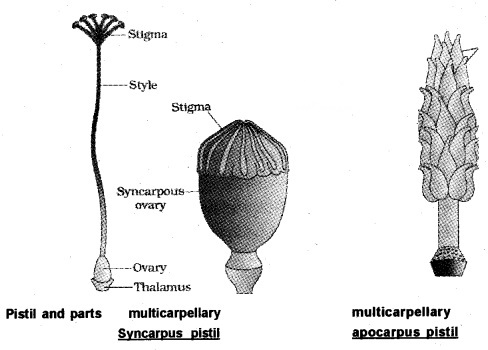
Each pistil has three parts the stigma, style and ovary. The stigma is the place where pollen grains falls. The style is the elongated slender part beneath the stigma.
The broad basal part of the pistil is the ovary. Inside the ovary is the ovarian cavity (locule). The placenta is located inside the ovarian cavity. The number of ovules in an ovary are different. It is one (wheat,paddy, mango) to many (papaya, water melon, orchids).
The Megasporangium (Ovule):
The ovule is a small structure attached to the p|acenta by means of a stalk called funicle. The body of the ovule fuses with funicle in the region called hilum (junction between ovule and funicle).
Each ovule has one or two protective envelopes called integuments. It covers entire ovule except at the tip where a small opening called the micropyle.
Opposite the micropylar end, is the chalaza, representing the basal part of the ovule. Enclosed within the integuments is a mass of cells called the nucellus.
Cells of the nucellus have abundant reserve food materials. Embryo sac or female gametophyte is located there.
Ovule structure
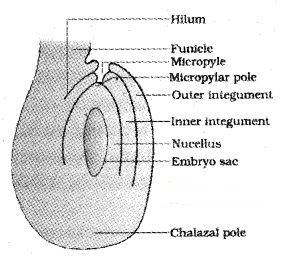
Megasporoqenesis:
It is the process of formation of megaspores from the megaspore mother cell. A single megaspore mother cell (MMC) is differentiates in the micropylar region of the nucellus.
It is a large cell containing dense cytoplasm and a prominent nucleus. The MMC undergoes meiotic division to form female gametophyte.
In most flowering plants, only one megaspore is functional while other three degenerates. Functional megaspore develops into the female gametophyte (embryosac). This is termed as monosporic development.
The nucleus of the functional megaspore undergoes three repeated mitotic division to form 8 nucleate embryosac. After the 8-nucleate stage, cell walls are formed leading to the organisation of the typical female gametophyte or embryo sac.
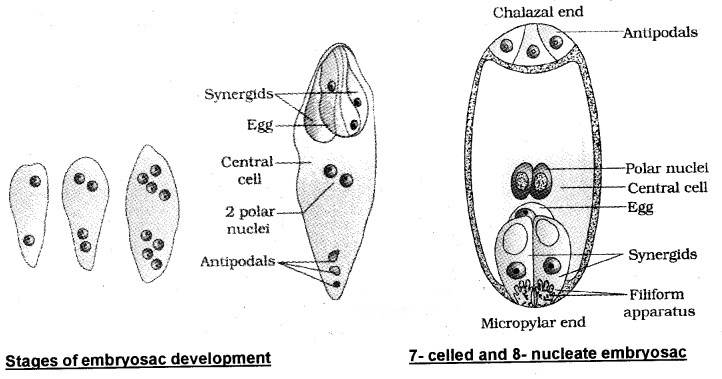
Six of the eight nuclei are surrounded by cell walls and organised into cells; the remaining two nuclei, called polar nuclei are situated below the egg apparatus in the large central cell.
Three cells are arranged at the micropylar end and constitute the egg apparatus. It consists of two synergids and one egg cell. The synergids have special cellular thickenings at the micropylartip called filiform apparatus, it helps to guide the pollen tubes into the synergid.
Three cells at the chalazal end are called the antipodals. The large central cell has two polar nuclei.
| Angiosperm embryo sac at maturity is 8-nucleate and 7-celled. |
3. Pollination:
It is the transfer of pollen grains to the stigma of a pistil.
Kinds of Pollination:
Depending on the source of pollen, pollination is divided into three types,
(i) Autogamy:
It is the transfer of pollen grains from the anther to the stigma of the same flower. In such flowers pollen release and stigma receptivity are at the same time and the anthers and the stigma should lie close to each other.
Some plants such as Viola, Oxalis, and Commelina produce two types of flowers – chasmogamous flowers (exposed anthers and stigma) and cleistogamous flowers (do not open flower). Cleistogamous flowers possible to the seed-set even in the absence of Pollinators.
Cleistogamous flowers
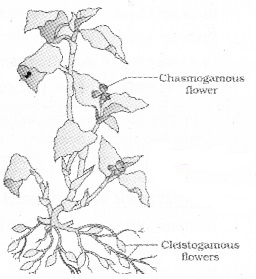
(ii) Geitonogamy:
Transfer of pollen grains from the anther to the stigma of another flower of the same plant. Functionally geitonogamy is a type of cross-pollination but it is genetically similar to autogamy since the pollen grains come from the same plant.
(iii) Xenogamy:
Transfer of pollen grains from anther to the stigma of a different plant. This type of pollination occurs between genetically different species.
Agents of Pollination:
Pollination takesplace with abiotic (wind and water) and biotic (animals) agents. Majority of plants use biotic agents for pollination.
Wind pollination:
Pollen grains are light and non-sticky. They possess well-exposed stamens and feathery stigma. Such flowers have a single ovule in each ovary and numerous flowers packed into an inflorescence.
Example -corn cob – Here stigma and style which wave in the wind to trap pollen grains. Wind-pollination is more common in grasses.
Wind pollinated plant with well-expesed stamens
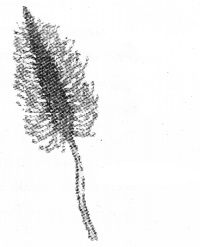
Water Pollination:
Water Pollinated plants are mostly monocotyledons. In the lower plants such as algae, bryophytes and pteridophytes required water for the transport of male gametes and fertilisation.
Some examples of water pollinated plants are Vallisneria and Hydrilla (fresh water) and Zostera (marine sea- grasses).

In Vallisneria, the female flower reach the surface of water by the long stalk and the male flowers or pollen grains are released on to the surface of water. The anthers eventually reach the female flowers and the stigma.
In seagrasses, female flowers are submerged in water and the pollen grains are released inside the water. Pollen grains are long and ribbon like, some of them reach the stigma and results pollination.
In a majority of aquatic plants such as water hyacinth and water lily, the flowers emerge above the level of water and are pollinated by insects or wind.
| In most of the water-pollinated species, pollen grains are protected from wetting by a mucilaginous covering. Both wind and water pollinated flowers are not very colourful and do not produce nectar. |
Animal pollination:
Animals pollinating agents are Bees, butterflies, flies, beetles, wasps, ants, moths, birds (sunbirds and humming birds) and bats.
Bees are the dominant biotic pollinating agent.
Larger animals such as some primates (lemurs), arboreal (tree-dwelling) rodents, or even reptiles (gecko lizard and garden lizard) have also been reported as pollinators in some species.
| Features of animal pollinated flowers are Flowers are large, colourful, fragrant and rich in nectar, the small flowers are clustered Into an inflorescence to make them conspicuous. |
The flowers pollinated by flies and beetles secrete foul odours to attract these animals. Flowers in turn provide rewards to the animals in the form of Nectar and pollen grains.
In some species flower provide safe places to lay eggs. Eg-tallest flower of Amorphophallus (Flower- 6 feet in height).
The plant Yucca and moth cannot complete their life cycles without each other. The moth deposits its eggs in the locule of the ovary and the flower in turn gets pollinated by the moth. The larvae of the moth come out of the eggs as the seeds start developing.
Outbreeding Devices
In plants the continued self-pollination result in inbreeding depression. Flowering plants have some devices to prevent self pollination and to promote cross-pollination.
- In some species, pollen release and stigma receptivity are not at the same time.
- In some other species, the anther and stigma are placed at different positions so that the pollen cannot come in contact with the stigma of the same flower. Both these devices prevent autogamy.
- In some other species self-incompatibility is the genetic mechanism Here pollen cannot germinate on the stigma of the same flower or other flowers of the same plant by inhibiting pollen germination or pollen tube growth in the pistil.
- Another device to prevent self-pollination is the production of unisexual flowers. If both male and female flowers are present on the same plant such as castor and maize (monoecious), it prevents autogamy but not geitonogamy.
In papaya, male and female flowers are present on different plants. This condition prevents both autogamy and geitonogamy.
Pollen-pistil Interaction:
After pollination, the pistil recognize pollen of the wrong type( incompatible )or the right type(compatible). If it is of the right type, the pistil accepts the pollen and promotes post-pollination events that leads to fertilisation. If the pollen is of the wrong type, the pistil rejects the pollen by preventing pollen germination on the stigma or the pollen tube growth in the style.
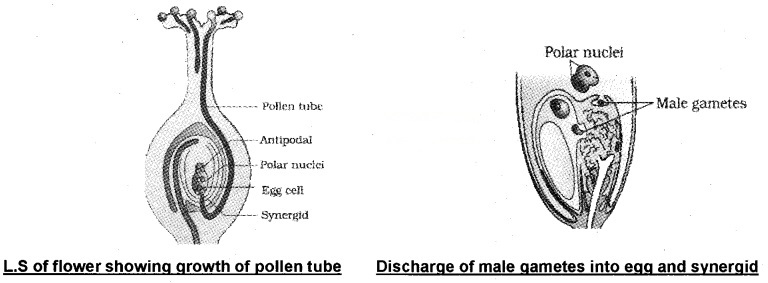
Pollen-pistil interaction is a kind of dialogue mediated by chemical components of the pollen interacting with those of the pistil.
Pollen tube grows through the tissues of the stigma and style and reaches the ovary. The generative cell divides and forms the two male gametes during the growth of pollen tube in the stylar region.
Then it enters into the ovule through the micropyle and reaches the synergids. It is reported that filiform apparatus present at the micropylar part of the synergids guides the entry of pollen tube.
Artificial hybridization:
It is the method for the crop improvement programme. It aims for the creation of’superior’ varieties.lt is done by emasculation and bagging techniques.
| Anthers are removed by using forceps before the dehiscence of anther of female parent that bears bisexual flowers. This step is called as emasculation. It is covered with a bag of suitable size, to prevent contamination of its stigma with unwanted pollen. This process is called bagging. When the stigma of bagged flower attains receptivity, mature pollen grains collected from anthers of the male parent are dusted on the stigma, and the flowers are rebagged, and the fruits allowed to develop. |
Emasculation is not necessary for unisexual flowers. Here female flower buds are bagged before the flowers open. When the stigma becomes receptive, pollination is carried out using the desired pollen and the flower rebagged.
Double Fertilisation
By the help of filiform apparatus, the pollen tube releases the two male gametes into the cytoplasm of the synergid. Then it fuses with the egg cell to form diploid zygote. This process is called syngamy.
The other male gamete moves towards the two polar nuclei located in the central cell and fuses with them to produce a triploid primary endosperm nucleus (PEN). This type of fusion contains three haploid nuclei, it is called triple fusion.
| Therefore syngamy and triple fusion take place in an embryo sac, the phenomenon is called as Double fertilization. The central cell after triple fusion becomes the primary endosperm cell (PEC) and develops into the endosperm while the zygote develops into an embryo. |
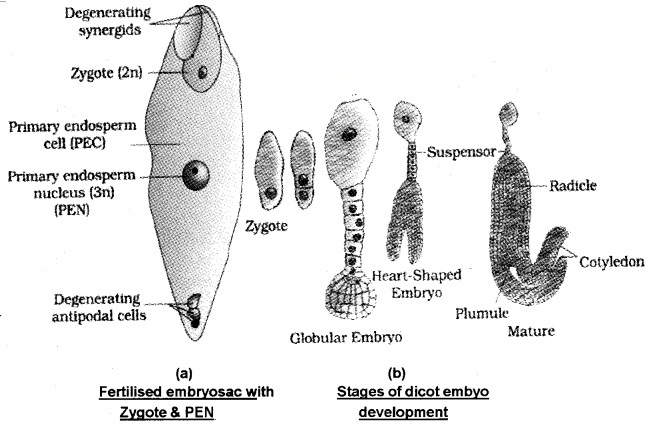
Post-Fertilisation: Structures And Events
Double fertilization leads to the development of endosperm and embryo, maturation of ovule into seed and ovary into fruit. These are called as post-fertilisation events.
1. Endosperm:
It serve as nutrition for the developing embryo. In most plants, the PEN undergoes successive nuclear divisions to give rise to free nuclei. This stage of endosperm development is called free-nuclear endosperm. Later cell wall formation occurs and the endosperm becomes cellular.
The tender coconut contains free-nuclear endosperm and the surrounding white kernel is the cellular endosperm. Some times the endosperm completely consumed by the developing embryo (e.g., pea, groundnut, beans) before seed maturation or it is persist in the mature seed (e.g. castor and coconut) and be used up during seed germination.
2. Embryo:
The micropylarend of the embrysac sac contains zygotes which divide only after the endosperm is formed. The early stages of embryo development (embryogeny) are similar in both monocotyledons and dicotyledons.
| The zygote gives rise to the proembryo and subsequently to the globular, heart-shaped and mature embryo. |
Dicotyledonous embryo consists of an embryonal axis and two cotyledons. The portion of embryonal axis above cotyledons is the epicotyl, which terminates with the plumule. The cylindrical portion below the cotyledons is hypocotyl that terminates at its lower end in the radical or root tip. The root tip is covered with a root cap.
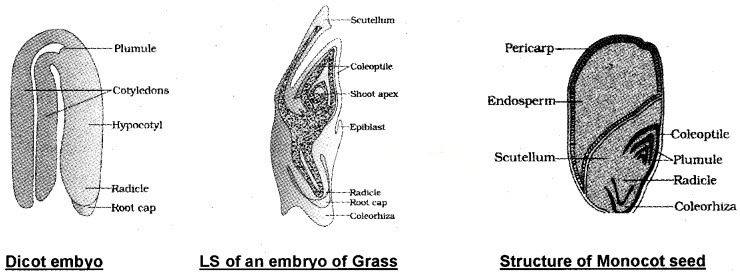
Embryos of monocotyledons possess only one cotyledon. In the grass family the cotyledon is called scutellum that rs situated towards one side of the embryonal axis. At its lower end, the embryonal axis consists of radical and root cap enclosed by sheath called coleorhiza.
The portion of the embryonal axis above the level of attachment of scutellum is the epicotyl. Epicotyl has a shoot apex and a few leaf primordia enclosed by a sheath called the coleoptile.
3. Seed:
In angiosperms, the seed is the fertilised ovule. Seeds are formed inside fruits. It consists of seed coat, cotyledon and an embryo axis. The cotyledons stores food reserves.
| Non-albuminous seeds have no endosperm because it consumed during embryo development (e.g., pea, groundnut). Albuminous seeds retain endosperm because it is not completely used up in embryo development (e.g., wheat, maize, barley, castor, sunflower). |
| In some seeds such as black pepper and beet, the remnants of nucellus are persistent. This persistent nucellus is called the perisperm |
The micropylar region facilitates entry of oxygen and water into the seed during germination. As the seed matures, its water content is reduced and metabolic activity of the embryo slows down. This inactive state of embryo is called dormancy.
If seed get suitable conditions, they germinates. During the embryo development ovules mature into seeds, the ovary develops into a fruit, integuments of ovules develops into seed coats and ovary wall becomes wall of fruit called pericarp.
Many fruits have evolved mechanisms for dispersal of seeds.

| 1. In some species such as apple, strawberry, cashew, etc., the thalamus develops to form fruit. Such fruits are called false fruits 2. Fruits develops only from the ovary, they are called true fruits. 3. In some species fruits develop without fertilization, they are called. Parthenocarpic fruits, eg- Banana. Parthenocarpy cgn be induced by the use of growth hormones. Such fruits are seedless. |
Dehydration and dormancy of mature seeds are important for storage So this is advantageous and to be used as food through out the year and also to raise crop in the next season.
In some species, the seeds lose viability within a few months but some seeds can remain alive for hundreds of years.
- The oldest seed is lupine, Lupinus arcticus excavated from Arctic Tundra.
- The seed germinated and flowered after of 10,000 years of dormancy.
- The 2000 years old viable seed – Date palm, Phoenixdactylifera discovered during the archeological excavation at King Herod’s palace near the Dead Sea.
Apomixis And Polyembryony
In some flowering plant species of Asteraceae and grasses produce seeds without fertilisation, it is called apomixis.
| Apomixis is a form of asexual reproduction that mimics sexual reproduction. In some species, the diploid egg cell is formed without reduction division and develops into the embryo without fertilisation. |
| But in a few species of Citrus and Mango, the nucellar cells surrounding the embryo sac develop into the embryos. In such species each ovule contains many embryos. The occurrence of more than one embryo in a seed is called polyembryony. |
Hybrids are widely used in cultivation as food and vegetable crops because of increased productivity, but their production is expensive for the farmers.
If these hybrids are made into apomicts, there is no segregation of characters in the hybrid progeny. So the farmers can use these apomictic seeds to raise new crop year after year without losing the desirable characters.
We hope the Plus Two Botany Notes Chapter 2 Sexual Reproduction in Flowering Plants help you. If you have any query regarding Plus Two Botany Notes Chapter 2 Sexual Reproduction in Flowering Plants, drop a comment below and we will get back to you at the earliest.
